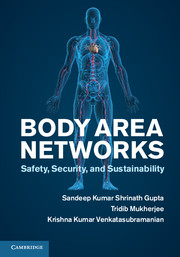Book contents
4 - Safety
Published online by Cambridge University Press: 05 April 2013
Summary
This chapter focuses on the various definitions, challenges, and approaches to BAN safety. Standard ISO 60601, a standard for medical devices, defines safety as the avoidance of unacceptable risks of hazards to the physical environment (i.e., to the patient) due to the operation of a medical device under normal or single-fault condition. Although this definition is akin to that for medical devices, it can be generally applicable to BANs as well, which are essentially networks of such devices. The standard further lists seven aspects of safety as follows.
Operational aspect. This aspect considers safety as the correct (and error-free) operation of the medical device, which might involve software, hardware, and electrical and mechanical operations, as well as the usage of medical devices in clinical processes (or medical scenarios).
Radiation aspect. This aspect of safety is geared towards ensuring that any radiation (e.g., X-ray radiation) from the device does not harm the patient.
Thermal aspect. This aspect of safety concerns the need to ensure that any heat dissipated because of medical-device operation and power consumption does not burn any part of the patient's body.
Biocompatibility. This aspect requires the materials used for the medical device to be compatible with the human body.
Software aspect. This aspect is essentially covered under the operational aspect; however, with the proliferation of software-enabled devices and sensors, special emphasis has been placed on correct operation of device software (e.g., code consistency and execution flow).
Mechanical aspect. This aspect principally requires that any actuation (e.g., the infusion process employed by an infusion pump) from the medical device does not cause harm to the body.
Electrical aspect. This aspect is intended to ensure that the device does not deliver any electrical shock to the body.
- Type
- Chapter
- Information
- Body Area NetworksSafety, Security, and Sustainability, pp. 36 - 62Publisher: Cambridge University PressPrint publication year: 2013

